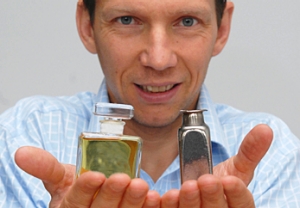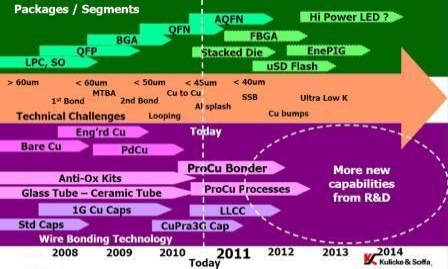February 21, 2011 — At Strategies in Light in Santa Clara, CA, Solid State Technology editor-in-chief Peter Singer will lead a roundtable panel on manufacturing issues and strategies for LEDs, as part of "Transforming the LED & lighting markets." Attend the workshop Tuesday, February 22 from 8 to noon.
In order to fulfill the promise of large LED market penetration in a variety of applications ranging from LCD display backlights to general illumination, the cost of large-volume LED production must continually fall, both at the chip and packaged device level. Singer’s workshop will explore in depth the advances in LED manufacturing technology that will be needed to reduce the cost of HB LEDs. Topics to be addressed include:
- The potential for process automation
- Yield management
- Metrology
- Move to larger substrates
- Adapting existing semiconductor facilities to LED
manufacturing.
Speakers:
 Thomas Uhrmann, Business Development Manager, EV Group (EVG).
Thomas Uhrmann, Business Development Manager, EV Group (EVG).
Thomas Uhrmann is business development manager for compound semiconductors and Si-based power devices at EV Group (EVG). In his current role, he is responsible to introduce and manage technological innovations for the fabrication of high-brightness light emitting diodes (HB-LEDs) at EVG. Uhrmann holds an engineering degree in mechatronics from the University of Applied Sciences in Regensburg, and a PhD in microelectronics from Vienna University of Technology. Uhrmann has authored and co-authored several papers on semiconductor diode structures, micro- or nanomagnetism and related areas.
 Chris Moore, President and CEO, Semilab AMS.
Chris Moore, President and CEO, Semilab AMS.
Chris Moore manages the US operations of Semilab that include Semilab USA and Semilab AMS, based in Billerica MA, and the Semilab SDI group in Tampa Florida. He is also a member of the Semilab Corporate management team. Semilab designs, manufactures, markets and sells optical metrology and contact and non-contact electrical characterization equipment for the semiconductor, PV and materials research markets. Chris is one of the co-chairs of SEMI’s HB-LED standards committee, currently co-chair of the SEMI PV Electrical and Optical Task Force, and co-chair of the recently formed 3D-ICs standards committee. As the VP technology of Waterloo Scientific, Chris helped develop compound semiconductor metrology equipment based on photoluminescence and high speed x-ray. When Waterloo Scientific was purchased by Philips, Chris became part of the Philips Analytical Waterloo and subsequently the Philips Boston management team. While with Philips Advanced Metrology systems Chris’s accomplishments include leading the design team which produced the MBIR infra-red reflectometry tool commonly used in the industry for 3D-IC etched structure metrology.
 Mike Plisinski, VP & General Manager, Rudolph Technologies Inc.
Mike Plisinski, VP & General Manager, Rudolph Technologies Inc.
Michael (Mike) Plisinski has served as Rudolph Technologies’ Vice President and General Manager, Data Analysis and Review Business Unit, since February 2006 when the Company merged with August Technology Corporation. From 2003 to 2006, his positions at August Technology included Vice President of Engineering and Director of Strategic Marketing for review and analysis products. Prior to joining August, Plisinski was founder and President of Counterpoint Solutions, a semiconductor review and analysis company, later acquired by August Technology. He has a B.S. in Computer Science from the University of Massachusetts.
 Ardy Johnson, VP Corporate Marketing, Rudolph Technologies Inc.
Ardy Johnson, VP Corporate Marketing, Rudolph Technologies Inc.
Ardelle (Ardy)Johnson is currently Vice President of Marketing at Rudolph Technologies. In this capacity, he oversees the Product Management, Communications, Strategic Market Research and Process Applications groups. Johnson held this same position at August Technology for before its merger with Rudolph in 2006. Prior to his tenure with August, Johnson was employed by FSI International, Inc. for twenty-five years, serving most recently as Vice President. Johnson has a B.S. degree from the University of Minnesota and an MS degree from the University of Wisconsin.
 Ravi Kanjolia, CTO, SAFC Hitech
Ravi Kanjolia, CTO, SAFC Hitech
Dr. Ravi Kanjolia, is responsible for linking SAFC Hitech’s expertise in electronics materials, chemistry and delivery systems to applications across the microelectronics industries, as well as maintaining a steady product pipeline for the future. He is also directly responsible for the worldwide R&D of SAFC Hitech and its external academic/industrial collaborations. Dr. Kanjolia’s main research interest is in the field of MOCVD/ALD precursors for compound semiconductors and silicon semiconductors for the fabrication of future generation semiconductor devices. Prior to joining SAFC Hitech (formerly Epichem), Dr. Kanjolia rose through a series of research and managerial positions at Morton Metalorganics (now Dow). Prior to that, he was an Assistant Professor at the University of Alabama at Birmingham (UAB).
 James Brodrick, Lighting Program Manager, US Department of Energy
James Brodrick, Lighting Program Manager, US Department of Energy
James Brodrick manages the U.S. Department of Energy Solid-State Lighting Program. Drawing on extensive technical and market knowledge, Dr. Brodrick has designed a comprehensive DOE strategy to move SSL from lab to market. The program comprises over 70 R&D projects, driving technology innovation and breakthroughs in efficiency and performance. Dr. Brodrick also has implemented a broad-based set of commercialization support strategies which closely coordinate with research progress to ensure proper application of SSL products and to avoid buyer dissatisfaction and delay of market development
 William Quinn, Chief Technologist, Veeco Metrology Inc.
William Quinn, Chief Technologist, Veeco Metrology Inc.
William E. Quinn is Chief Technologist at Veeco MOCVD Operations. He has a BA in chemistry from Rutgers University and a Ph.D. in Material Science and Engineering from Stevens Institute of Technology. Prior to joining Veeco in 2004, he was engineering director at Skyworks solutions in Woburn, MA. Bill has been involved in research and production of III-V epitaxy materials for more than 25 years.
Moderator:
 Peter Singer has been covering the semiconductor and related industries for more than 26 years. Now Editor-in-Chief of Small Times, Photovoltaics World, and Solid State Technology/Advanced Packaging, he was previously with Semiconductor International. He has authored more than 200 articles on all aspects of semiconductor manufacturing and related industries, including optoelectronics, photonics and photovoltaics. He has a degree in electrical engineering from the University of Illinois, Champaign-Urbana.
Peter Singer has been covering the semiconductor and related industries for more than 26 years. Now Editor-in-Chief of Small Times, Photovoltaics World, and Solid State Technology/Advanced Packaging, he was previously with Semiconductor International. He has authored more than 200 articles on all aspects of semiconductor manufacturing and related industries, including optoelectronics, photonics and photovoltaics. He has a degree in electrical engineering from the University of Illinois, Champaign-Urbana.
Subscribe to Solid State Technology/Advanced Packaging.
Follow Solid State Technology on Twitter.com via editors Pete Singer, twitter.com/PetesTweetsPW and Debra Vogler, twitter.com/dvogler_PV_semi.
Or join our Facebook group





 Thomas Uhrmann, Business Development Manager, EV Group (EVG).
Thomas Uhrmann, Business Development Manager, EV Group (EVG).  Chris Moore, President and CEO, Semilab AMS.
Chris Moore, President and CEO, Semilab AMS. Mike Plisinski, VP & General Manager, Rudolph Technologies Inc.
Mike Plisinski, VP & General Manager, Rudolph Technologies Inc. Ardy Johnson, VP Corporate Marketing, Rudolph Technologies Inc.
Ardy Johnson, VP Corporate Marketing, Rudolph Technologies Inc. Ravi Kanjolia, CTO, SAFC Hitech
Ravi Kanjolia, CTO, SAFC Hitech James Brodrick, Lighting Program Manager, US Department of Energy
James Brodrick, Lighting Program Manager, US Department of Energy William Quinn, Chief Technologist, Veeco Metrology Inc.
William Quinn, Chief Technologist, Veeco Metrology Inc.





